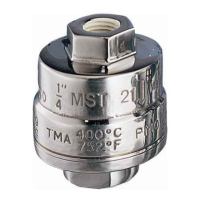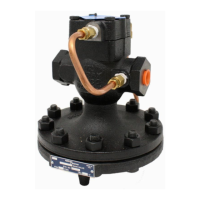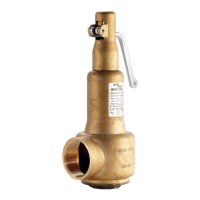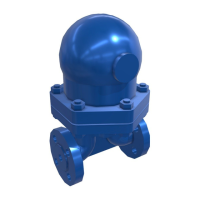12
Once installation and/or maintenance procedure is completed, compare materials instructions
and valve pressure and temperature conditions with the operating conditions, in order to verify its
resistance and capacity.
Before commissioning the unit, check that the system is fully operational and carry out functional
tests on all the alarm and protective devices.
During commissioning procedure, always proceed with caution as the initial operations are critical
andcanpresenthazardousconditions.Graduallyincreasethepressureandprogressivelyopen
the valves by turning the handwheel counter clockwise, in order to avoid any sudden variations in
pressure and/or temperature. Simultaneously, check that there are no steam leaks at the valve or
at the pipe connections until the normal operating pressure will be reached. In presence of leakage,
immediately release the plant pressure and run the valve installation once again, replacing the seals.
Iftheleakageisatthestungboxgaskets,immediatelyreplacethebellowsassembly.
Note: the manual handwheel is designed proportionally to the force required to open and close
thevalveunderalloperatingconditions(Usually,valvesareutilizedinfullyopenorfullyclosedpo-
sitions).Itisstronglydiscouragedtheuseofauxiliaryleversortoolstoopenorclosethevalve,as
thiscouldinvolveexcessiveforcecausingdamage.Whenthevalveisinfullyopenposition(withthe
spindlefullylifted),rotateitclockwiseby⅛÷¼ofaturntoeliminateanybacklashandtoprevent
subsequent probable damage to the spindle, the bellows assembly and other valve components.
Carry out several opening and closing cycles of the isolation valve, to verify that is working properly.
Checkthestungboxgaskets(especiallywhenthevalveisusedforthersttimeatitsdesignope-
ratingpressureandtemperature)andcheckthecorrecttightnessofboltsonthevalvebody/cover
assembly, considering that bolts should be evenly cross-tightened, respecting the recommended
tighteningtorques(asshowninthetableonpag.10),particularlywhenthevalveisloadedorheated
forthersttime,orinpresenceoftracesofleakageatvalvebody/covergaskets.
Note:duringlongperiodsofplantshutdown,itisrecommendedtodrainalluidsfromthepipeline
in view of the fact that, for their physical and chemical characteristics, they tend to modify their
concentration, to polymerise, crystallise or undergo any other change of state. If necessary, all the
pipelinesshouldbeushedwiththevalvesinfullyopenposition.
5. Commissioning
6. Maintenance
Note: Before starting any maintenance work, read the "General Safety Instructions" in section 1.
Maintenanceworkonvalvesshouldbecarriedoutonlybyauthorised,qualiedpersonnelandin
fullcompliancewithAccidentPreventionLegislation.
BSK1 Valves are designed and manufactured to require minimal maintenance. To ensure proper
andsafesystemoperation,(particularlyincaseofreducedaccessibilitytothevalveorwhenthe
valveisoccasionallyoperatedandhasalimiteduse)itisrecommendedtocarryoutregularsche-
duledinspections.Ispectionsfrequencyshouldbedeterminedbythemaintenancemanager(butit
isadvisableamonthlyfrequency,atleast)andwilldependonthespecicvalveuseandtheplant
characteristics(natureofthemedia,operatingtemperatureandpressureetc...).
Inadditiontoscheduledinspections,averageoperatinglifetimeofthevalvemaybeextendedby
performingperiodicreplacementofsealsandgasketsandbylubricatingmovingparts(Spindle).
Before uninstalling the valve from the pipeline or carrying out any repair/maintenance intervention
always insulate any piping involved, then release the pressure to atmospheric levels and allow the
valve to cool under safe conditions.
Beforetheirhandlingortransporting,valvesmustbethoroughlycleanedanddrained(anyresidual
uidmustbesuitablyrecoveredanddisposed).
Note: the gasket between valve body and cover has a stainless steel core which can cause physical
damage if it is not removed and disposed with due caution.

